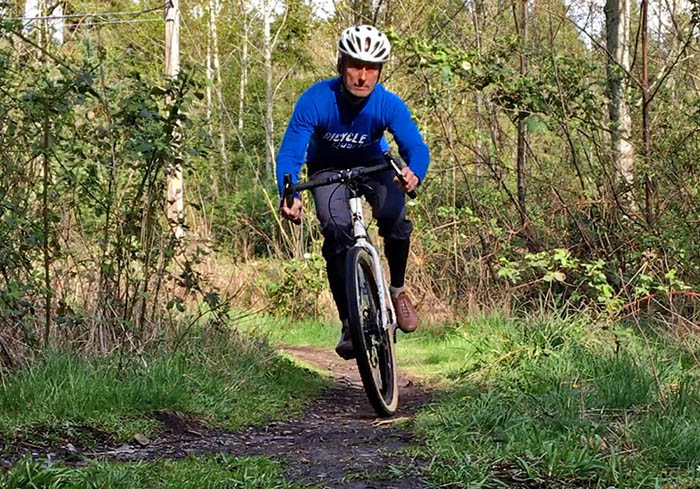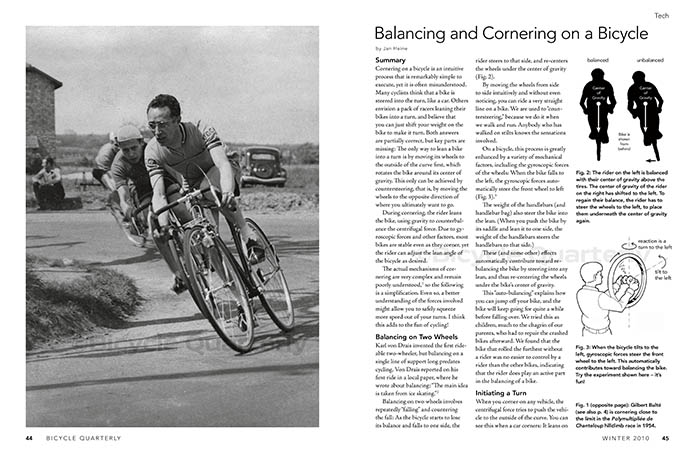Myths Debunked: You CANNOT Lean without Countersteering

Glancing at the photo above, you might think that I am turning right (seen from the rider’s view). Actually, I am beginning a left turn. What you see is countersteering – literally the only way we can lean a bike into a corner.
This post is part of our ‘Myths in Cycling’ series to celebrate Bicycle Quarterly’s 15th anniversary. In these posts, we examine things we used to believe, but which we’ve since found not to be true. It’s actually been known since the 1860s that you can’t just lean a bike, but that you have to countersteer to make it fall into the turn. But that knowledge hasn’t really entered mainstream cycling, so let’s look at this in more detail.
Countersteering is how a bike leans: You move the wheels to the outside of the corner, so the bike becomes unbalanced and leans into the turn. The video above illustrates this as I take BQ’s most recent test bike, the Surly Midnight Special, through an S-bend.
At first, you see the bike leaning to the right (seen from the rider’s perspective) as I finish the right turn. Then I quickly have to lean the bike to the left. To do this, I first steer further to the right. This pulls the bike upright again. I continue to steer to the right, and now the bike begins to lean to the left. Only when the bike is leaning at the desired angle do I turn the handlebars to the left to steer the bike around the turn.
The section in the middle, where the bars are turned right while the bike already starting to lean left impressively illustrates how countersteering shifts the bike’s balance. On most bikes, this happens intuitively – I never thought about steering to the outside of the curve while riding the Surly around those bends. Countersteering is intuitive, because we do it when we walk and run, too. Only when a bike’s geometry is too stable, then we have to actively countersteer to get the bike to turn.
Can’t we simply shift our body weight to one side and make the bike lean and turn? It’s not that simple, because inertia keeps the bike balanced (2): If you move your body right, the bike will move left: Your center of gravity remains centered above the wheels.

That is why you can rock the bike when you climb out of the saddle, yet continue to ride in a straight line.
However, if you continue to lean the bike to the left, the bike’s front-end geometry turns the handlebars to the left. The wheels move to that side, and you get the same countersteering that makes the bike lean right. That is how riding no-hands works: You lean right, the front wheel automatically countersteers, and then the bike leans right and you turn.
Similarly, ‘steering from your hips’ can turn the handlebars to initiate that countersteering move. However, I suspect that even riders who ‘steer from the hips’ actually turn the bars to countersteer – otherwise, the bike would react very slowly, as it does when riding no-hands.

In BQ 34, we examined these factors in detail. Back then, Jim Papadopoulos and others had just revolutionized our understanding of bicycle geometry: They showed that even a bike without trail and without gyroscopic forces can be stable. We worked with Jim to translate these findings into a clear understanding of how a bike balances and corners. The article provides fascinating insights that have made me appreciate bicycles all the more.
Conclusion: Whether we realize it or not, we are always countersteering when we lean our bikes into a turn.

Update 11/17/2020: We’ve just published our new book ‘The All-Road Bike Revolution’ with all the research that has changed cycling in recent years. Find out why wide tires can be fast, how to find a frame that optimizes your power output, and how to get a bike that handles like an extension of your body. More information is here.


